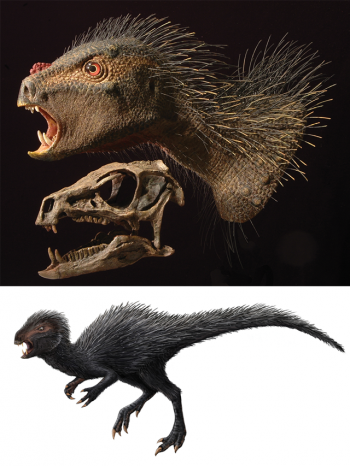What traits distinguish one dinosaur from another? For many, that question probably conjures characteristics like the massive jaws of tyrannosaurs, the distinctive horns and plates of ceratopsids and stegosaurs, and the exceedingly large bodies of sauropods and their kin. But for paleontologists looking to classify different dinosaurs, it’s all about the shapes, or morphologies, of the animals’ bones.
With a knowledge of the morphological traits of dinosaur bones and enough of a fossil skeleton, paleontologists can broadly identify where on the dinosaur tree a specimen fits. Then they can look to other traits—specifically those shared by subsets of dinosaurs—to figure out where the animal belongs in more detail.
The dinosaur family tree we use today was first published in 1887. After studying the orientation of the bones that make up dinosaurs’ hips, paleontologist Harry Seeley proposed that all dinosaurs fit into one of two groups, based on the structure of their pelvises. As in all tetrapods, the dinosaur pelvis, where the hips attach to the spine, is made up of three bones: the illium, the ischium and the pubis. He found that, in some species, like the sauropods, the pubic bones point toward the front of the body, while in other species, such as the duck-billed hadrosaurs, they point toward the back, running parallel to the ischia. Seeley called the former group Saurischia, meaning “lizard-hipped,” because of the resemblance of the orientation of these animals’ hip bones to those in lizards; animals in the latter group became Ornithischia, meaning “bird-hipped,” because of the similarity of their hip structure to that of modern birds. From those two broad branches in Seeley’s classification sprung more specialized groups of dinosaurs, including the theropods—saurischians that include tyrannosaurs, dromaeosaurs and birds, among others.

This split between bird-hipped and lizard-hipped dinosaurs has been entrenched among dinosaur researchers since Seeley’s days. But in a 2017 study in Nature, a team led by paleontologist Matthew Baron of the University of Cambridge in England proposed a radical reconfiguration of that arrangement. Baron and his team suggested that the ornithischian-saurischian classification should be set aside in favor of a revised tree in which the dichotomy in hip structure is not all-encompassing. This new classification combines theropods with ornithischians in a new group called Ornithoscelida, while the sauropods and herrerasaurids—an early group of carnivores that died out in the Triassic—remain as the saurischians (technically sauropodomorphs).

Such a reorganization, involving branches near the base of the dinosaur family tree, represents a major overhaul—one that challenges an orthodoxy built on roughly a century and a half of research. Among the many implications, the new classification suggests that carnivory in dinosaurs evolved independently at least twice, in herrerasaurids and theropods. With both of those groups previously considered saurischians, it appeared carnivory had evolved just once. Also, feathers, once thought to occur across multiple dinosaur lineages, now seem to have evolved in only the theropods—the line that led to the birds. Additionally, it was unclear from Seeley’s long-standing family tree whether the last common ancestor of all dinosaurs was lizard- or bird-hipped, or how many times the evolutionary transition from one to the other conformation might have happened. The new tree implies that the first dinosaur was lizard-hipped and that bird-hipped morphologies evolved later in multiple ornithoscelidan lineages, specifically among the ornithischians and several theropod groups.
But many paleontologists are not ready to accept the revised tree; such a big shift in our understanding of dinosaur evolutionary history is a steep proposition, and some researchers are calling for caution and more study.
All About the Bones

The key to differentiating dinosaur groups is anatomical data, specifically related to bones. However, those data, because they can be somewhat subjective, are not always easy to define. A paleontologist looking to distinguish one dinosaur species or group from another logs differences in bone morphologies. If enough differences are logged, a picture emerges of how dinosaurs are distinct animals—from the clade level all the way down to individual species.
Broadly, dinosaurs as a whole are distinguished from other reptilian groups like pterosaurs by the presence of a hole in their hip sockets. Although hip bones have been the major focus, there are numerous other bones to consider as well: femurs and teeth, for example. While sauropods like Apatosaurus had relatively straight femurs resembling the columns that support ancient Greek temples, theropods like Tyrannosaurus rex had femurs with more of a bowed shape. Within sauropods, meanwhile, there are distinctions in tooth morphology: Some have spatula-shaped teeth while others have more peg-like teeth.
This is essentially what Baron and his team did in their 2017 study: They assembled a dataset of morphological features that they thought best distinguished dinosaurs, including everything from unique openings in the skull to the varying shapes of different limb bones. In total, they looked at 457 traits from 74 different dinosaur taxa, with most of their data coming from previously published scientific literature. Although the researchers didn’t set out to fundamentally reshape the dinosaur family tree, Baron explains, their findings led them to do just that.
A Gnarly Tree Trunk
The exercise of parsing features to distinguish dinosaur species gets trickier the closer you get to the base of the dinosaur evolutionary tree, where the major groups diverge. The early species that are known all tend to look somewhat similar, and paleontologists often have a hard time telling who’s who. That is the root of the debate, because those early dinosaur species—called dinosauromorphs—are key to deciphering the base of the dinosaur family tree, says Steve Brusatte, a vertebrate paleontologist at the University of Edinburgh in Scotland, who co-authored a response in Nature rebutting the Baron team’s revised tree.
One of those early species is the Late Triassic Eoraptor lunensis, known from a nearly complete skeleton found in the Valley of the Moon in northwestern Argentina. Eoraptor was a bipedal dinosaur that lived about 230 million years ago on the supercontinent Gondwana. About the size of a dog, it lived before dinosaurs were the top predators on the landscape, and before they diversified into the many famous forms known today.

Eoraptor lunensis had forelimbs that appear adapted for grasping, and it looks like it is the “perfect, standard-issue basal dinosaur,” Baron says, because it appears it could be almost any dinosaur’s ancestor—which is a problem when it comes to figuring out which dinosaurs might be its direct descendants. “Eoraptor is a nightmare … there are as many opinions on what Eoraptor is as there are workers in the field,” Baron says.

Baron and his colleagues think the grasping forelimbs resemble those of later theropods. Other researchers, including Paul Sereno, a paleontologist at the University of Chicago who helped discover E. lunensis in the 1990s, think it is a member of the sauropodomorphs—ancestors of the sauropods—based on things like its thumb. The bones of its thumb twist such that the side of the thumb contacts the ground, which is a hallmark trait of later sauropodomorphs, Sereno says.
Another early dinosaur, Heterodontosaurus tucki, categorized as an ornithischian based on features like its bird-hipped pelvis, was found in Early Jurassic rocks in South Africa in 1961. But it “has a large number of features that were only otherwise seen in the meat-eating dinosaurs, the theropods,” says Paul Barrett, a dinosaur specialist at the Natural History Museum in London and a co-author of the 2017 study that proposed the new tree. It was H. tucki’s similarities to theropods—including long, slender shoulder blades, an outgrowth at the front of the hip for muscle attachment, and forelimbs adapted for grasping, as in E. lunensis—that first led Baron, Barrett and their colleagues to think that “something more complicated was going on” regarding the dinosaur tree.
H. tucki “is an ornithischian,” Barrett says, but based on the proposed new tree, it appears it’s more closely related to the theropods than researchers have thought.
Where these early dinosaurs reside at the base of the family tree has significant implications for the structure of the overlying branches. But the uncertainty surrounding the identity of early dinosaurs—what they were, and which later dinosaurs they were most closely related to—means that their positions on the evolutionary tree are not settled. “They move all around the family tree” depending on whom you ask, Brusatte says. “Some of these weird species have combinations of [characteristics from] different groups. They can cause trouble, but those species can also provide clarity. They can unite groups together,” he says.
Deciding What’s Most Important
But before they can define anything, scientists have to come to an agreement on how important or relevant various morphological characteristics, such as thumb shape, are compared to others when it comes to deciphering relationships. And how should these characteristics even be assessed? It’s all too subjective, Sereno says.
Sereno says that the current way dinosaur paleontologists assemble and use datasets, and thus how they build evolutionary trees, needs to change. “You can make a hypothesis and literally ignore a huge part of the data that somebody else used to look at the same group,” he says.
When researchers assess bone morphology, for example, they might describe a particular part of a bone as being round or square-shaped, but that assessment is up to each researcher. Furthermore, if someone can’t decide whether the morphology is round or square, they might simply note the characteristic as “absent.” But, Sereno explains, absence or presence has nothing to do with shape—the quality of interest—so describing a shape as absent obscures the meaning or relevance of the characteristic with respect to deciphering evolutionary relationships.

Standardizing the assessment of dinosaur characteristics and the use of datasets is one of the only ways to get around the issue of researcher subjectivity, Sereno says. “We need more rules.”
How those new rules might take shape is unclear, but until standardization occurs, different results and different evolutionary trees will continue to emerge whenever different researchers run analyses. Following the proposal to revise the dinosaur tree in 2017, for instance, Brusatte and his co-authors studied the same set of characteristics that Baron’s team had used in its study. They went through each morphological trait considered in the study and reinterpreted them based on their own expertise. What they came up with was a tree that supported the traditional ornithischian-saurischian arrangement. Brusatte says subjectivity is “just the nature of the game.”

What everyone involved in the debate seems to agree on is that “we really need more fossils: especially new fossils of Triassic dinosaurs from near the base of the dinosaur family tree that can help untangle the relationships of these lineages,” Brusatte says. “[The debate] has revealed that something we thought was a certainty is actually a mystery. And so that mystery has to be solved.”
Baron agrees: “It could be that two or three discoveries make all the difference.”
For now, which version of the dinosaur family tree—the traditional or revised—comes closer to the truth remains unclear. Meanwhile, to surmount differences in opinion and create a standard set of metrics with which to parse fossils, “we need a lot more collaboration” among researchers, Baron says.
Lead image: The current dinosaur family tree, which is fundamentally based on differences in hip morphology, has been in use since 1887. Scientists have recently proposed reorganizing some of the tree’s biggest branches. Credit: K. Cantner, AGI.
This article was originally published in Earth Magazine on February 4, 2019.


























